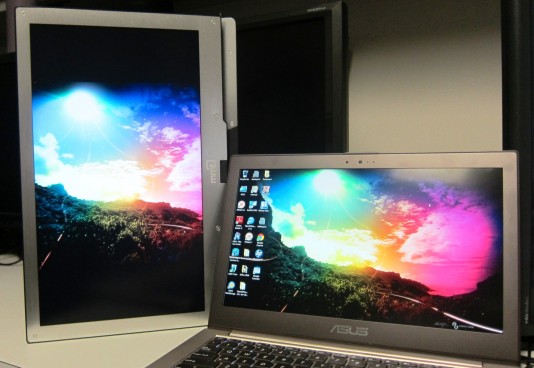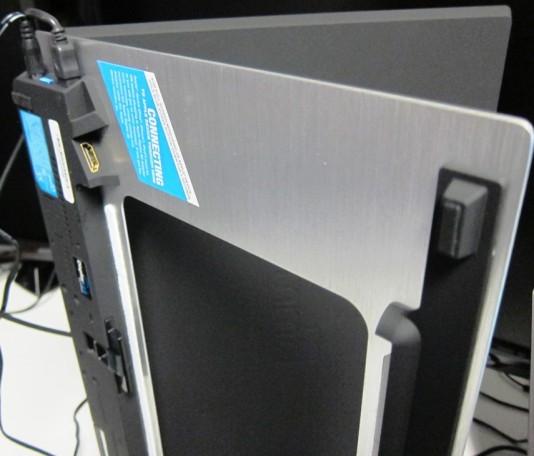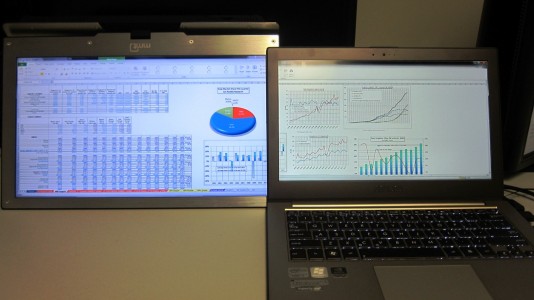See more, do more. This new monitor makes it easier to do more on the road.
By Jon Peddie
The world is a better place. Monitor prices and weight have gone down while size and resolution have gone up. Ultrabooks have brought us light weight and HD screens, as well as lightweight power supplies. Life is better.
One year ago—in fact as late as four months ago—I, and other road warriors like me carried a 15-inch (or a 13-inch) 6- to 8-pound laptop with a one-and-a-half to two-and-a-half pound power supply. The screen might be HD, but more often than not it was a squinty 1366 x 768 – oy.

At this year’s CES, DisplayLink-powered Multiple Monitor Technologies’ (MMT) 3-pound (with power supply 3.56 pound or 1.61 kg), Monitor2Go 15.6 inch, 1600 x 900 0.45-inch and 1.09-inches thick portable monitor was this traveler’s wish come true. Selling for around $300, and not taking up much room or adding much weight, it frees me from trying to use a hotel room HDTV as a second monitor.
The brushed aluminum MMT M2G has a clever swing-and-rotate center hinge that sets up like a clamshell laptop, or flip over like a tablet, or stand up like a picture frame. The base has a cutout in it, and a snap-in plastic box, which seems to be the only failing of the design. The box is pulled out to allow a tablet (and as far as MMT seems concerned, that only means iPad) to be dropped in.
The plastic box would seem an ideal tablet holder if turned upside down, but due to the curved edges, it will only fit in one-way—flat (back?) surface up (facing, and protecting the screen). There is also a pull down (or out) arm that can be used to support the monitor when used as a second display or digital picture frame. It’s easy to see a lot of design thought went into this device.
A small wall-plug power supply powers the screen, and a mini-to-standard USB cable connects to the PC for DisplayLink signals. Inside the monitor is the DisplayLink decoder chip. A small blue (could easily be missed if you didn’t read the instructions) power switch is between the power connector and mini USB. On the other end of the monitor are two expansion USB slots—all USB2. There is also a HDMI connector.

The native screen resolution on the M2G is 1600 x 900 but when connected via the HDMI connector it scales flawlessly and beautifully to 1920 x 1080 – in either orientation—really impressive. The monitor has a 400:1 contrast ratio, delivers 220 Nits (candela per square meter – cd/m2), and offers a 8ms response time.
Putting it in Portrait mode, I get 1920 lines and can see an entire web page without scrolling. The viewing angles are 65 degrees horizontal, 55 degrees vertical.
When working on one of our ridiculously massive spreadsheets, which used to be a real chore when traveling, I can now spread it out across 3840 pixels by 1080 – which is actually more than my 30-inch center screen at the office, and almost a 27-inch (diagonal) display. Working on the road will never be the same.
The screen does have a bluish tint to it, which means it is probably running around 9300 K while the typical Ultrabook is probably at about 5700 K. That’s not a complaint, just an observation. If you were working in an incandescent lighting environment you might actually prefer a bluish tinted bias.

We ran the monitor from the HDMI connection and from the DisplayLink USB connection and were able to get it to display 1920 x 1080 with both inputs, which is really impressive.
Monitor2Go is available now in two models: HD+ with 1600 x 900 resolution at $329, and HD with 1366 x768 resolution for $299.
So an Ultrabook like the Asus Zenbook UX31E with power supply is 3.6 pounds or 1.6kg, and the Monitor2Go weighs 3.6 pound which means my kit is 7.2 pounds (3.2 kg). I haven’t lost any weight in my brief case, but I’ve gained over 2X the screen resolution and display space. That’s a pretty good trade-off in my opinion.





